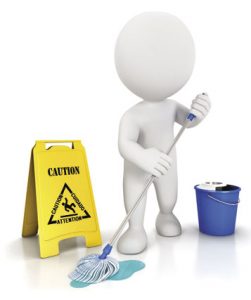Ensuring that a building, site or location is kept clean is not only a legal requirement, but it can have a positive impact on visitors to the organisation. And in the current COVID-19 pandemic, it is crucial that businesses are doing all that they can to instil confidence in their workforce and visitors that premises are clean.
 The FM sector as a whole and particularly the cleaning industry, has had to be dynamic in its response to the challenges of the pandemic.
The FM sector as a whole and particularly the cleaning industry, has had to be dynamic in its response to the challenges of the pandemic.
COVID-19 – CLEANING CONSIDERATIONS
With the COVID-19 pandemic in mind, consideration should be given to the range of cleaning requirements that are needed to ensure you are working to COVID-19 safety standards and complying with government guidance on cleaning.
COVID-19 – RISK ASSESSMENT
Employers are required to protect people from harm, and this includes taking reasonable steps to protect workers and others from COVID-19.
Before deciding what cleaning is suitable for the premises, a risk assessment will be needed to help you manage risk and decide how best to work safely and protect people during the pandemic. The risk assessment will help identify what your cleaning regime will look like.
The COVID-19 risk assessment will also determine whether the business requires a full-time cleaning team or fewer cleaning staff to deal with the situation.
RISK CONTROL MEASURES
- Ensure consistent regular cleaning processes are in place across all sites. Large sites may require cleaners to be based on site throughout the day to carry out routine cleaning.
- Ensure additional cleaning of high-risk areas such as door handles, surfaces, light switches, lift control panels etc.
- The cleaning team must ensure they always maintain social distance during cleaning and wash hands after cleaning.
- Provide clear information and guidance to cleaning personnel to ensure they are aware of the tasks.
- Monitor cleaning and any concerns should be raised immediately to line managers.
- Encourage colleagues to raise any concerns or requests with their line manager.
- Once a risk assessment has been carried out, premises should display the government notice to show the workplace has complied with the guidance on managing the risk of COVID-19.
GENERAL CONSIDERATIONS
Cleaning can involve accessing all parts of a site or building exposing operatives to the full range of risks on that site. Operatives may work at height, access confined spaces or work on their own.
MANAGING THE RISKS
- Ensure that an excellent cleaning service is in place either by in-house provision or by outsourcing.
- Ensure that in-house cleaning staff or cleaning contractors are vetted appropriately before commencement of work.
- Ensure high levels of training are provided in the case of in-house cleaning provision to prevent risk of accidents and illness.
- Ensure that valuable assets and confidential information are kept secure.
- Consider the access requirements for cleaning contractors.
- Address work at height requirements especially for window cleaners.
- Consider slips, trips and falls by, for example, ensuring wet floor signs are always used, and cleaners use electrical sockets nearest to where they are working to reduce the risk of tripping over leads and cables.
- Review health and safety requirements if the premises have recently been refurbished.
- Make sure that suitable COSHH assessments are carried out and are up to date.
- For workers involved in cleaning of leisure centres, spas, jacuzzis or shower heads, a risk assessment should be available outlining what measures are in place to manage and prevent the risk from legionnaire’s disease.
- Where healthcare is provided, ensure that cleaning regimes take account of standards of personal hygiene and infection control.
- For catering facilities ensure that high standards of personal hygiene are adopted and Sducts and flues are regularly inspected and cleaned.
- Consider the safety of cleaning contractors.
- Ensure temps are briefed on safety procedures by the supervisor before beginning work.
- Ensure procedures are in place to address lone working; for example, cleaning staff sign in/out – if they have not signed out by 7.15 pm, security staff should look for them.
- Provide cleaning staff with details of fire emergency procedures, including location of fire exits.
- Ensure suitable first aid arrangements are in place for cleaning operatives.
- Provide site information to cleaning staff and establish if it needs to be provided in languages other than English.
- Determine what personal protective equipment (PPE) is required for cleaning staff.
- Make sure that cleaning equipment is subject to suitable maintenance regimes.
 Ensure that staff are trained in basic electrical safety and do pre-use visual checks for any equipment used.
Ensure that staff are trained in basic electrical safety and do pre-use visual checks for any equipment used.- Where fall arrest, access equipment and safety devices are provided make sure that they are subject to adequate inspection and testing.




